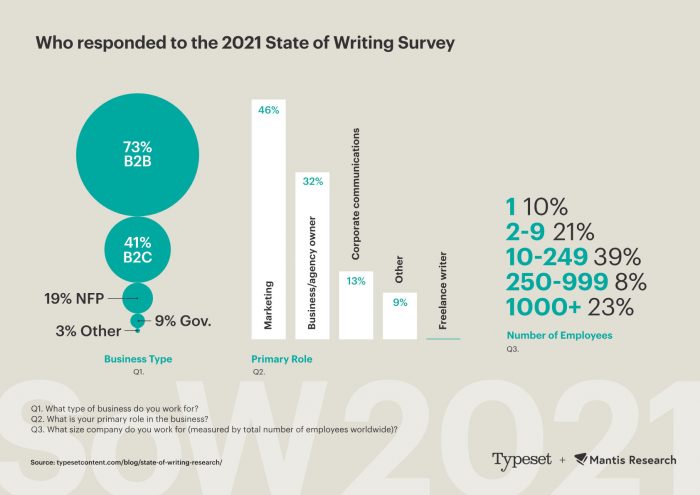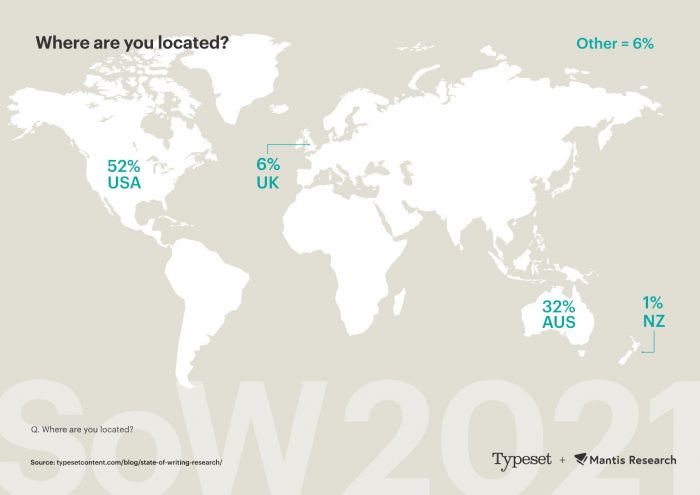
Have content marketers thrown in the towel?
Business communicators say they are feeling positive about the writing process but report low satisfaction levels with the performance of their writing initiatives. What’s most surprising is this is coming from a group with a lot of experience in writing and publishing.
These are key findings from the second annual State of Writing report from Typeset® and Mantis Research.
Something is clearly wrong. Have those producing written content for their business lost motivation or is there something else at play?
This year we took another deep dive into the topic of writing effectiveness to help business communicators – marketers, communications professionals and business owners – gain a better understanding about how to improve the return on investment in their writing projects. State of Writing 2021 shows us where we’re experiencing success and where there’s room for improvement.
The good news is if we have lost our mojo, it’s not too late to get it back! The results also show a clear path for content marketers and other business communicators to get back into the groove of writing effectiveness.
Let’s dig in.
Full disclosure: We struggled to attract the same number of respondents as we did for our inaugural research report. We had a total of 204 respondents this year from all over the globe. Our methodology is at the end of this report.
This year we added a new question to gauge the experience levels of people participating in State of Writing 2021. More than half of the 204 respondents completing the 2021 survey reported they have at least 11 years of personal experience in writing and publishing. Only 19% said they had less than five years of experience.
In addition, more than half reported their organisation has been publishing content for more than six years. This is up seven percentage points from last year’s report.
Key takeaway: The results of the 2021 survey are from a mature group of writers with extensive experience in publishing content. This is exactly the kind of people we want to learn from.
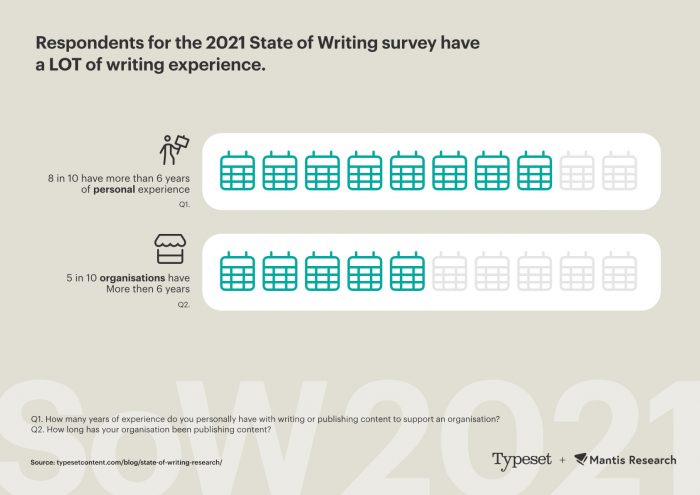
Despite the impressive amount of experience in writing and publishing, 70% of respondents said they’re only somewhat satisfied or not satisfied at all with the performance of their written content in the past 12 months. It’s not what we expected to learn from such an experienced field of business communicators.
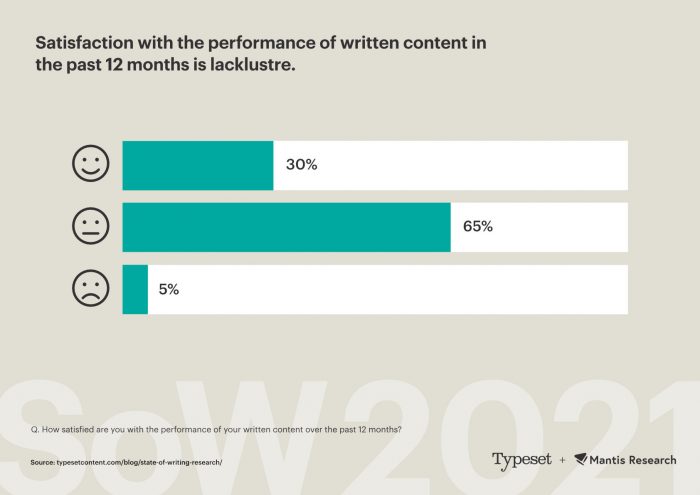
So why aren’t people getting better results even after all this time working at it?
We asked Doug Kessler, Creative Director and Co-founder at Velocity Partners, what he made of this. Doug was also surprised that only 30% of respondents are very satisfied with the performance of their written content.
“My guess is that people are just NOT working at it – they’re doing it but not consciously trying to improve,” Doug said.
“The industry has accepted Meh as the acceptable standard.”
Given there doesn’t seem to be an attitude problem, what’s causing the overwhelming majority of writers to see room for improvement?
“There’s a strong sense of giving up in all this: of settling for less,” Doug said.
“The fact that only 5% were ‘not satisfied’ with the performance of their written content may be even more disturbing. We’ve all seen the content out there. Way more than 5% of it is bad. If only 5% of people THINK it’s bad… something is wrong.
“For me, writing is one of those ‘hard things’ that, because it’s hard, people give themselves permission to be mediocre at it.
“Instead of ‘Writing is hard: I have to work harder at it’, we get ‘Writing is hard: we can expect a so-so result’.”
Key takeaway: Achieving success with written content is not easy, regardless of how much experience you have. The rest of the report contains several clues on what it takes to improve writing effectiveness.
Dig Deeper: 10 things you can do to improve your writing
We wanted to get a sense of how people were feeling about their writing efforts when so many business communicators were forced to react to a global pandemic. They said they’re still on top of their game with “optimistic”, “energised” and “inspired” the top answers. Less than a third are feeling “overwhelmed” and very few are feeling “bored” or “confused”.
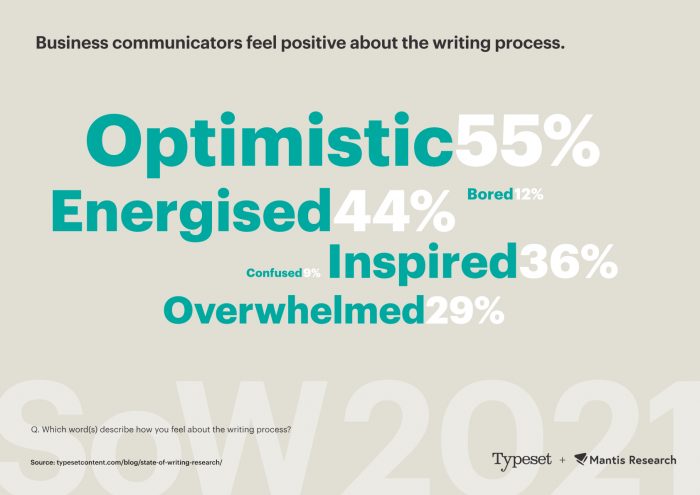
They’re an optimistic bunch, despite not being overly impressed with the results of their writing efforts. Why is that?
It’s no wonder business communicators are falling out of love with content marketing. Even though 61% of businesses plan to increase the writing they produce, only 39% are planning to increase their budgets in the next 12 months. This is similar to findings in our State of Writing 2020 research. Who could blame business communicators if they’re pressed to do more with fewer resources?
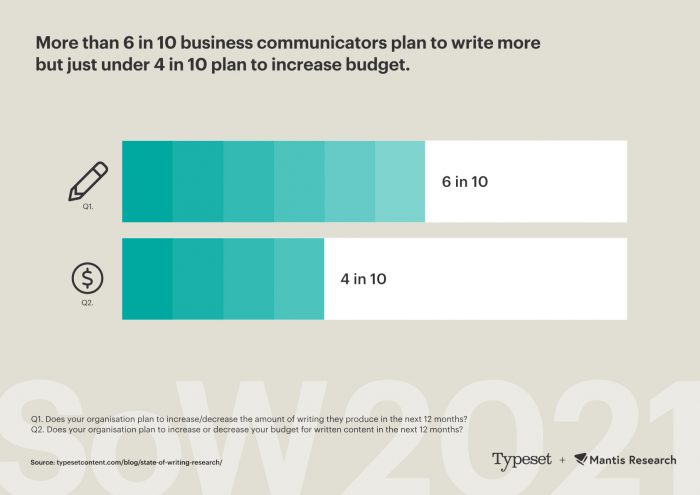
In 2021 there is a glimmer of hope with an increase in those who report they will reduce the amount of written content – a clear step in the right direction.
Key takeaway: Focus on reducing the amount of written content you publish, but spend more time crafting more-effective written content.
Dig Deeper: The high cost of poor writing and what you can do about it
Like they reported last year, business communicators are most challenged with “knowing what my audience wants to read”. In 2020, 49% of respondents reported this was difficult, compared to 38% in 2021.
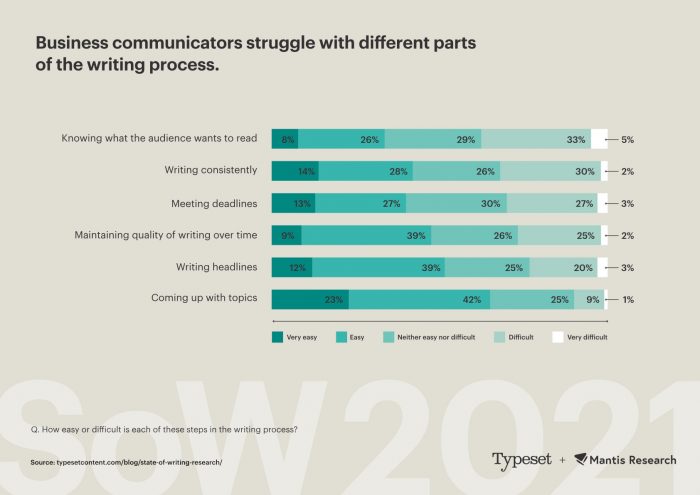
To find out why this critical step of the writing process was so difficult, we asked a new question to uncover how business communicators discover what their audience wants to read. What we found out surprised us, mostly because the simplest remedy is the thing the fewest respondents do – talk to customers. Instead, they are relying on feedback from analytics, social media and sales/customer support. Less than half are participating in communities where their customers are present.
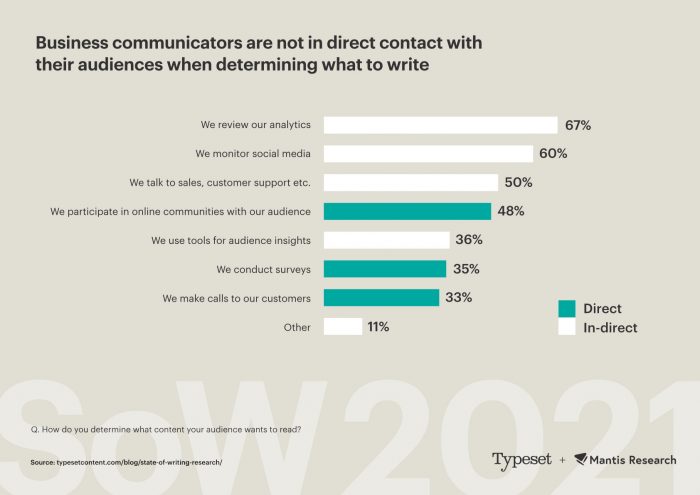
Michele Linn, co-founder of Mantis Research (our research partner), provided additional insight into the conundrum of writing for an audience when you don’t know what they want to read.
“While I can’t say I’m surprised, I am disappointed that only a third of business communicators are talking to their prospects and customers,” Michele said. “Instead of relying on third-party sources, go straight to the source.”
With a long history of content marketing and editing under her belt, Michele offered this tip for business communicators.
“As a starting place, create a set of questions you can ask so you can understand this person’s process and pain points. But be flexible and dig into areas where the conversation naturally goes.
“From my experience, people have been very willing to have these types of conversations – and they usually lead to unexpected insights.”
Key takeaway: Don’t rely on data to tell you the whole story. Pick up the phone or schedule a meeting with customers. Get into the habit of interviewing your customers so you’re continually hearing from them directly.
Dig Deeper: 18 secrets to more effective writing
Next, we wanted to find out what business communicators can do to realise a better return on their writing investments.
Even though 86% of business communicators agreed readers will judge their brand negatively if they see errors in written content, they’re not doing enough about it. Only 34% send all their content for proofreading and only 56% fact-check all their content.
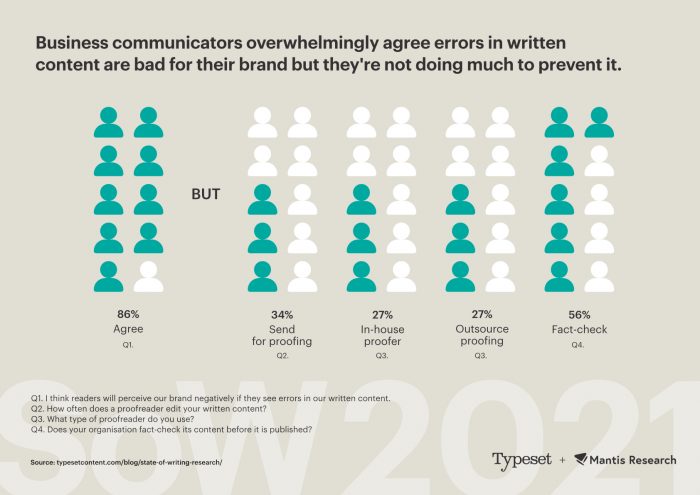
We asked Janine Pares, Managing Director of TSM, to share her insight into the disconnect between the importance of quality control processes and the lack of widespread implementation.
“I think that’s really telling about the lack of investment across the full content creation process, or the misconception that content writing is a one-person job,” Janine said.
“While one person may have the expertise to write well – or be tasked with the writing – they need the support of others to make sure it’s fit for publishing.
“You need to check the information is accurate, it’s positioned appropriately for the target audience, the tone of voice is aligned to the brand, and any typos are cleaned up.
“Quality is crucial – there’s no doubt about that – but it doesn’t begin and end at the writing.”
Key takeaway: If you expect to produce quality content, you can’t take shortcuts. Writing is a team effort requiring people with different skills to produce the best results.
Dig Deeper: Proofreading tips to save your business embarrassment
About half of this year’s respondents said they considered SEO (search engine optimisation) to be difficult. That might explain another major disconnect between thoughts and actions when it comes to creating the most-effective written content. Nearly six in 10 respondents said SEO is a high priority for their business but only 2 in 10 always conduct keyword research before they publish content.
Next we asked what part of on-page SEO activities respondents include in their writing process before they publish online. As it turns out, the majority of respondents are doing a lot. Only 5% said they weren’t doing anything and more than half are addressing all the critical functions required for online content to perform well.
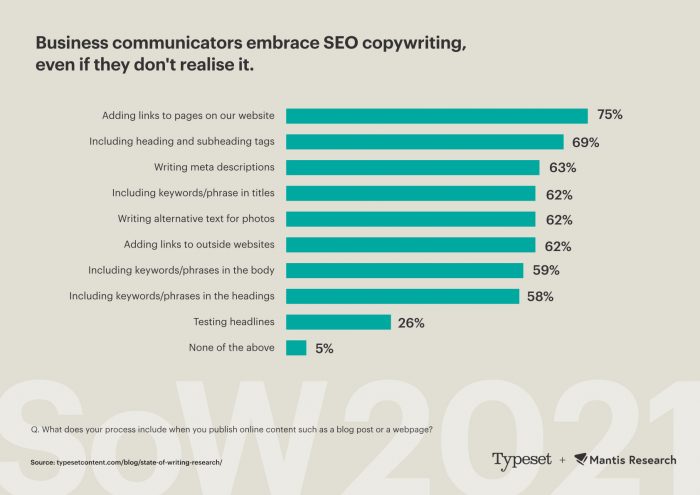
Since so many respondents admitted to having difficulty with SEO, we checked in with Andy Crestodina, Co-Founder and Chief Marketing Officer at Orbit Media Studios and author of Content Chemistry, for his view on why business communicators are struggling. We’re glad we did.
“There is more to life than search,” Andy said.
“It’s definitely not the only channel for content promotion.
“But look at these numbers – most writers are researching key phrases and incorporating them into content.
“That means most copywriters are now SEO copywriters. It’s simply part of the normal process for content creation.”
Even though they said it’s hard, these experienced business communicators are tackling many of the critical components required to improve their search rankings.
Key takeaway: Whether you realise it or not, you’re probably already doing a lot of on-page SEO. Embrace the discipline.
Dig Deeper: 12 SEO tips to make your writing more effective
Business communicators feel very bullish about brand voice. Eighty-two percent who reported it’s extremely or very important for their brand to have a voice that is different from competitors. And, 75% believe they’ve achieved a brand voice that’s different from their competitors.
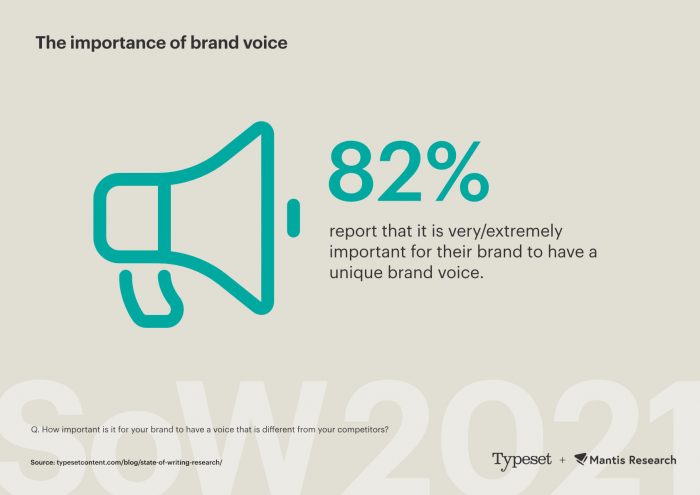
That’s a little astonishing – and maybe aspirational – especially when you factor in that only 30% of respondents are very satisfied with their writing efforts. As Doug Kessler pointed out, that’s a whole lot of “Meh”.
Astrid Fackelmann, Brand Manager at Floveyor, was encouraged to see the high percentage of business communicators who believe brand differentiation will give them a competitive edge.
“The traditional techniques of building brand voice continue to apply in the digitalised and automated marcom world,” Astrid says.
“Marketers who understand how to integrate all touchpoints based on deeper insights will continue to build trustworthy brands.”
But Astrid believes business communicators need to be cautious in their pursuit of standing out in a competitive field.
“Personalising the brand voice throughout the customer journey will remain a challenge,” she says.
“Building one-to-one applications and remaining respectful of the privacy of stakeholders will be key to moving ahead.”
Key takeaway: Marketers wanting to gain competitive advantage by differentiating on brand voice need to dig deep to personalise the customer journey and not rely on programmatic techniques which can begin to feel creepy instead of personal.
Dig Deeper: 5 Tips to improve the readability of your writing
Business communicators have been dealing with upheaval throughout the pandemic.
Respondent insight
“I think COVID-19 has made it hard to concentrate on the task at hand sometimes. There has been a shift in what people care about and have time for, with many professionals juggling being a parent, teacher, and business person at the same time, whereas, in the past, they could keep them separated better.”
But new ways of working have also provided improvements in editorial rigour.
Last year 45% of respondents said they did not have anyone overseeing the content they publish, compared to 15% this year. That’s a huge improvement, possibly because the majority of respondents in 2021 are experienced professionals. The other reason could be because this year we dug deeper into what role is responsible for content oversight. When provided with specific choices, respondents may have realised they actually do have editorial oversight.
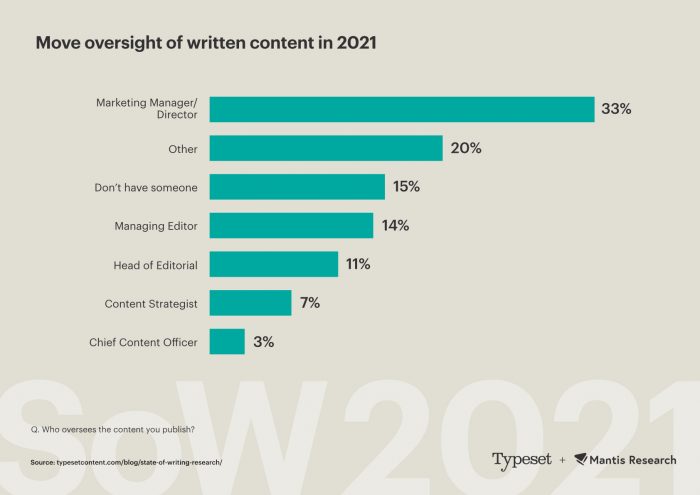
Dig Deeper: Do you need an editor or a proofreader?
Maybe it’s because so many of us were stuck at home, or because there was so much more information to communicate due to the pandemic. Most likely, it was a combination of both.
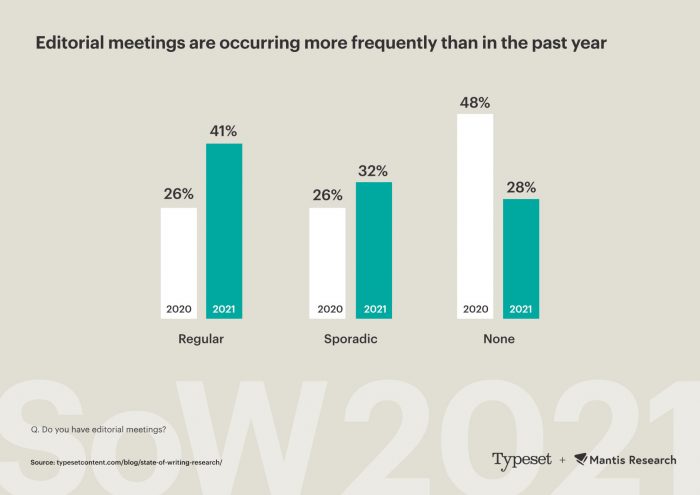
The number of business communicators who said they’re using a strategy is 75%, up 21 percentage points from last year. Again, this big swing in the right direction could be because of the experience level of the respondents. This year we added brand personas and digital policies to the mix of editorial tools and less than half of respondents admitted they use them.
Respondent insight
“It has become more important than ever to be relevant to the target audience, due to the increase in competition for their attention. Also had to focus on not being viewed as exploiting COVID to sell something. We don’t want to be viewed as exploitative.”
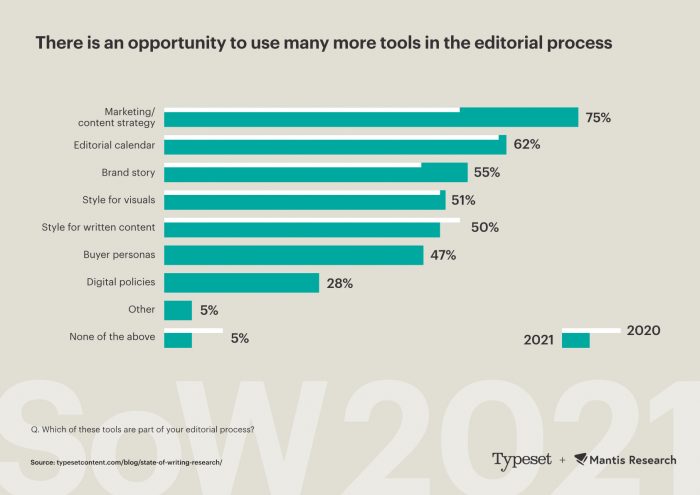
Respondent insight
“It’s forced us to think more carefully about our tone and message, to show genuine empathy and make sure we aren’t just adding to the noise. We’ve also had more time to think about ways to share the value we bring to our clients via written content.”
Key takeaway: Business communicators have a chance to consider whether additional tools could contribute to increased editorial rigour in their organisation.
Dig Deeper: Three things to do before you even start content marketing
Business communicators have relied on written content more this year than in the past, as evidenced by an increase in high-frequency content including blog posts and newsletters, compared to last year.
Social media updates, press releases and annual reports are the kinds of content being produced that have seen the biggest increases this year compared to last. Understandably, given widespread lockdowns and work-from-home arrangements, there’s been a decrease in presentations. Surprisingly, there’s been less investment in website copywriting and copywriting, in general.
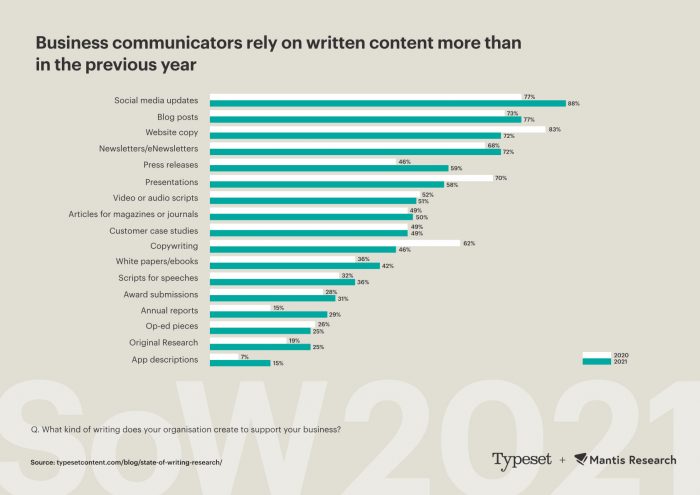
It hasn’t always been easy. Many people completing the survey said COVID-19 affected content production due to the subject matter for what they write changing.
Respondent insight
“Covid 19 has caused me to focus on more direct and targeted written content. With more demands on my time professionally and personally, it is more important than ever that what I write directly impacts the bottom line and moves the Key Performance Indicators in the right direction. Time is a luxury right now.”
While it was a tough year for many, respondents felt the investment made in written content in the past 12 months was worthwhile.
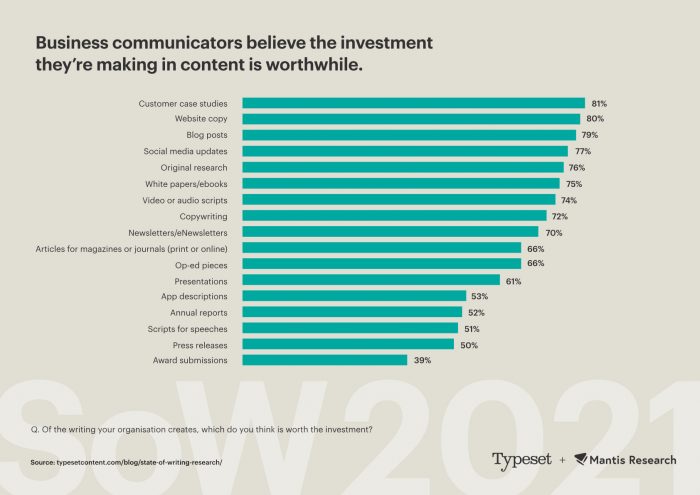
Content marketing expert Erika Heald said she wasn’t surprised social media finished so high in the survey results but suggested business communicators might want to use a bit of caution when assessing whether social media is really worth it.
“Social media content can seem like an inexpensive, high-impact communications activity. It’s fantastic for building engagement with your community and gaining brand awareness,” Erika said.
“But overall, for most of my B2B clients, it isn’t typically very effective for driving direct sales or signups for webinars and events.”
Erika wonders if business communicators are using the right criteria to think about the ROI on their social media content.
“Those who have seen the biggest return for their social media investment have had somewhat sizeable social advertising budgets to increase the reach and audience for their content, which in some cases outpaces the spend on their blog content.”
On the lower end of the value scale, only 50% of respondents felt their investment in press releases was worth it and 39% said awards submissions were a good investment.
It’s worth noting the number of people who are using each type of content when reviewing this data. The “worth the investment” percentages are based on the number of responses to each type of content. Some of the content types do not have a large number of users.
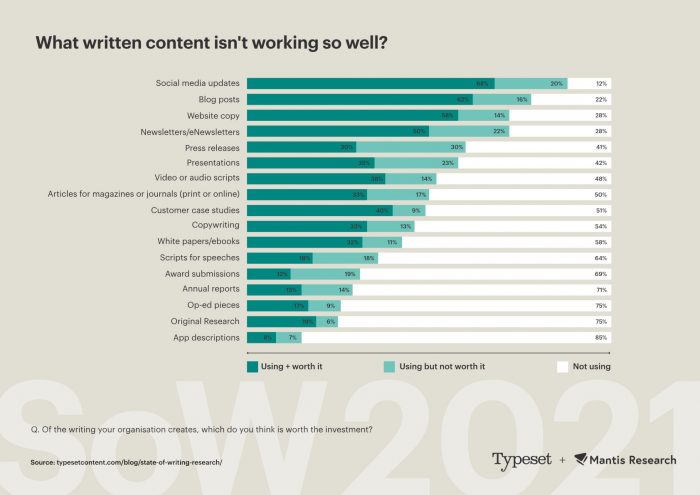
Respondent insight
“No longer writing scripts for events and MC briefings at events. More focus on video scripts, grant submissions to trusts and foundations. Less about our needs, more about donor focus and IMPACT.”
Key takeaway: Consider how well each kind of content is performing for your business, especially if you’re faced with budget cuts. Before you axe part of your content strategy, evaluate whether you can make improvements in the writing process.
While the assessment about written content investments were positive, business communicators reported their written content is helping meet business goals. The two most common goals are acquiring customers and maintaining customer loyalty. The majority of those who want to reach these goals are doing so. This is great news for content marketers who have long believed in the business benefits of producing written content to drive profitable customer action.
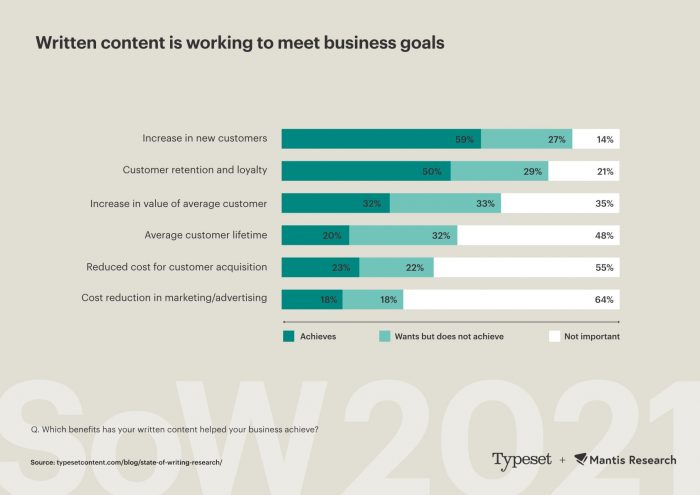
Taking into consideration the maturity of our respondents, we checked in with Joe Pulizzi, bestselling author and founder of the Content Marketing Institute and the Orange Effect Foundation, to get his opinion about how business communicators should be approaching content marketing if they’re not seeing the same results.
“If an organisation leads with accomplishing a marketing goal first, they probably won’t succeed. First and foremost, you need to have the audience’s needs and pain points in mind. The entire focus should be about how the organisation can help their audience in any way possible,” Joe said.
“Then, you create a consistent plan to help that audience by delivering articles. If you do it correctly, over a long period of time, they should opt in to receive your content messages and become a loyal member of your community.”
We asked a new question in this year’s survey about whether business communicators are taking Joe’s advice here and using written content to build an email list. Two-thirds said they are.
Joe says once you build your community, and not before, you can accomplish goals like better customer retention or increase in lifetime value.
“Everyone rushes to the brand’s goal when they should be rushing to create solutions for their audience, outside of the products and services they sell,” Joe said.
Key takeaway: Content marketing is working and is contributing to the bottom line of many organisations. To achieve long-term business goals that impact the bottom line of your business, start by building a loyal audience. Creating an email newsletter is a good way to achieve this goal.
Dig Deeper: How to create a ‘must-read’ email newsletter
The good news is that many of the fixes required to make writing more effective are relatively easy to make. There’s probably not a lot you can do about tight budgets, especially in the middle of a global pandemic. Continuing to measure and demonstrate value to the business is going to help.
When everyone has been forced to adapt to new ways of working – and many more of us are relying on information found online as businesses are reducing face-to-face meetings – written content is a powerful tool to keep your key stakeholders informed and to differentiate your brand.
Here are our top suggestions for improving the performance of your content:
We’ll be expanding on these topics, introducing additional insight and adding more depth to our research results in the coming year, both here and in the Typeset newsletter.
If you’re not subscribed, now is a good time to join the hundreds of people who receive The Write Fit every fortnight. Don’t hesitate to get in touch if you have any questions, especially if you’d like information on what you can do to improve the quality of writing in your organisation.
Typeset commissioned Mantis Research to survey business communicators to understand how businesses use writing to achieve their goals. We wanted to find out how well their writing is working. The results are from an online survey that was open from 11 November 2020 to 25 January 2021. The 204 respondents represented a broad mix of people responsible for marketing and communications. All rely on writing effectiveness in their organisations. This is how they are represented in our research.
